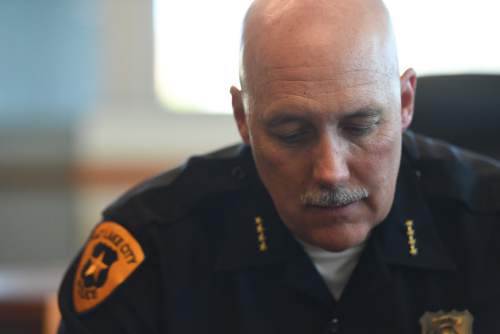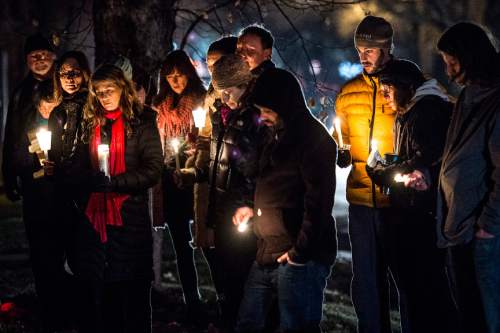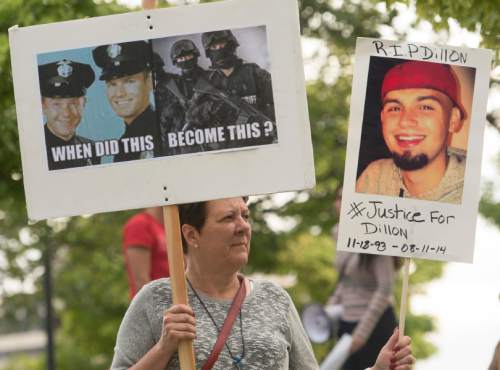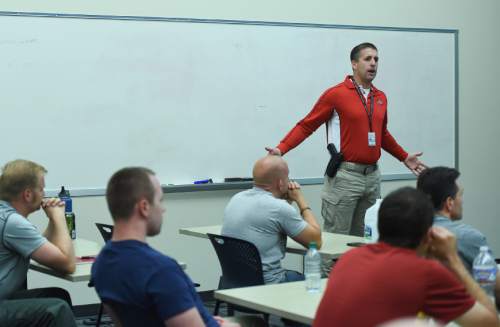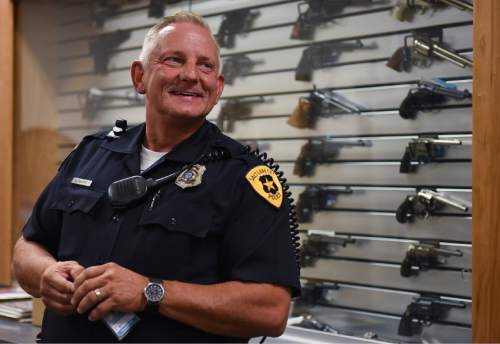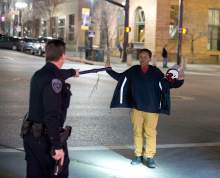This is an archived article that was published on sltrib.com in 2016, and information in the article may be outdated. It is provided only for personal research purposes and may not be reprinted.
Salt Lake City police Officers Travis Morgan and Steve Winters drew down on a suspected armed bank robber shortly after noon July 25 near 2000 South and Main.
At the end of a frantic foot chase, the officers approached the man from different angles but held their fire even though the suspect had one hand on a pistol in his waistband. Morgan instructed the man to take his hand off the weapon and to lie down on the ground. After a few moments, the suspect complied.
Under Utah law, the officers could have used deadly force if they believed their safety was at risk.
That tense but bloodless confrontation is evidence that de-escalation techniques taught in the department work, said Police Chief Mike Brown.
He described de-escalation as a complex set of training standards. They include tactics, verbal skills and an empathy for those with whom police come in contact. But there is no cookie-cutter formula, the chief explained, because every situation is unique and some require split-second decisions.
Like many other volatile encounters that ended without bloodshed, the peaceful capture of the bank robber didn't make the news.
What did make headlines in Salt Lake City recently was the Aug. 11, 2014, officer-involved shooting death of Dillon Taylor, 20; the Jan. 8, 2015, officer-involved shooting death of James Barker, 42; and the Feb. 27, 2016, officer-involved shooting of Abdi Mohamed,1 7, who survived but now uses a wheelchair.
All three shootings were ruled justified by Salt Lake County District Attorney Sim Gill, although the Mohamed shooting later was deemed "outside procedure" by the Salt Lake City Police Civilian Review Board — an apparent rebuke of the D.A.'s finding.
Body-cam videos of the Taylor and Barker shootings ignited public furor. Taylor was unarmed. Barker had a snow shovel but seemed peaceful until, under the officer's persistent questioning, Barker struck him with the shovel.
Gill has refused to release body-cam video in the Mohamed shooting, saying the criminal case against the teen is ongoing. But witnesses insist Mohamed, who is now 18, was carrying a hollow metal mop handle and was involved in an altercation with another man, not police.
—
Community confidence • Across the country, deaths of unarmed civilians by law-enforcement officers have sparked controversy and changes in how at least some police deal with civilians.
The primary buzzwords in the shift? "Police de-escalation training." The new approach seeks to build community confidence in police — something that also demands two-way communication and transparency.
At the heart of de-escalation is slowing things down, Brown said. Buying time gives police more options to keep an encounter from igniting into violence.
Some aspects of tactical training that fall under de-escalation are not new. For years, police have been instructed to keep a safe distance and stay close to cover when approaching potential danger. Those tactics are aimed at providing time for them to seek nonviolent outcomes, rather than forcing a self-defense scenario that could end badly.
Newer techniques in de-escalation involve verbal communications that are not commands but are intended to open dialogue with a potential suspect. Politeness and empathy are emphasized, Brown said.
De-escalation should also take into account the demeanor of suspects: Are they nervous, frightened, drunk, unstable?
"We teach our officers to read a situation and communicate," Brown said. "That provides all kinds of options."
Salt Lake City police also receive disengagement training — to take stock and determine when it is advisable for an officer to back away from a dicey dispute, particularly when groups of people are involved.
Not least among the new strategies is training in bias. Officers should recognize that people of different cultures and races may react differently to police presence.
Some veteran patrol officers pooh-pooh the new approach. Nonetheless, police training is evolving toward a softer approach that fosters cooperation rather than ultimatums and violent arrests.
"It's a two-way street," Brown said. "When you give respect, you get respect."
—
Residents speak up • Barker's January 2015 death spawned a grass-roots movement of Salt Lake City residents who sought change in police procedures. Members of the Community Coalition for Police Reform — including activists from other community groups — approached the administration of then-Mayor Ralph Becker and former Police Chief Chris Burbank with little success, said Heidi Keilbaugh, Barker's partner.
Only after a protest she helped organize in the wake of the shooting of Mohamed did the administration of new Mayor Jackie Biskupski invite group members to meet with police, she said. They now hold regular discussions with Brown and other officers.
"The main driving force behind this is that no one should have to experience the death of a loved one who died needlessly," Keilbaugh said. "We can do better."
She sees the group playing the role of "common-sense consultants" with the aim of helping cut through red tape at the police department and City Hall.
Another member of the group, Deeda Seed, a former Salt Lake City councilwoman who also served as chief of staff to former Mayor Rocky Anderson, said the new access to the police department is unprecedented.
"We have never had this kind of openness with the police — ever," Seed said.
Brown and his officers have listened, she noted, and the department is making progress.
"We have a real opportunity to do this the right way. But we have to better understand each other," Seed said of interaction between residents and police. "We're very concerned about understanding what our police officers do and why they do it."
The Barker, Taylor and Mohamed shootings show more must be done, Seed explained.
In the Barker case, the officer did not appear to take into consideration the demeanor of the man who was seeking work shoveling walkways. He was clearly under stress before he hit the officer, Seed said.
The officer was responding to a call of a "suspicious person" who may have been a burglar.
"What the officer should have done was back away and call someone else [for backup]," she said. "Instead, he pushed and pushed and it led to a horrible tragedy."
The video of the Taylor shooting is equally disturbing, Seed said. An officer approached Taylor, who was walking away from a convenience store. The officer, who had responded to a "man with a gun" call, commanded Taylor to turn around and show his hands, which were tucked into his sweatpants. When Taylor turned and raised his shirt, he was shot dead.
In neither the Barker nor the Taylor shootings did officers follow the time-honored training of leaving space and obtaining cover.
Other de-escalation techniques also appear to be missing.
The Mohamed case seems more complex. But, Seed said, she has new confidence in the Civilian Review Board's finding that the youth was shot "outside procedure" set by the police department.
"The problem is that none of us have seen the video. It's a blank box," she said. "It's problematic, and there is no good reason for Sim Gill not to release that video."
The lack of the video undercuts transparency and therefore compromises community trust in law enforcement, Seed said.
Gill disagrees. While he champions transparency, he said, it is unlawful for the district attorney to identify a juvenile, which releasing the video would do. Gill added that making the footage public could hamper the defendant's ability to get a fair trial.
Mohamed is charged with aggravated assault, a first-degree felony and drug possession with intent to distribute.
Both Gill and Brown say they know the value of transparency in building community trust.
Nonetheless, Brown said he would not second-guess the officer's behavior in the Barker case, and he could not speak to the Taylor or Mohamed shootings due to pending and threatened litigation.
"What I want to say is that we have looked at these [incidents] as a way to train and do a better job," he said. "We look at how we can improve our training."


